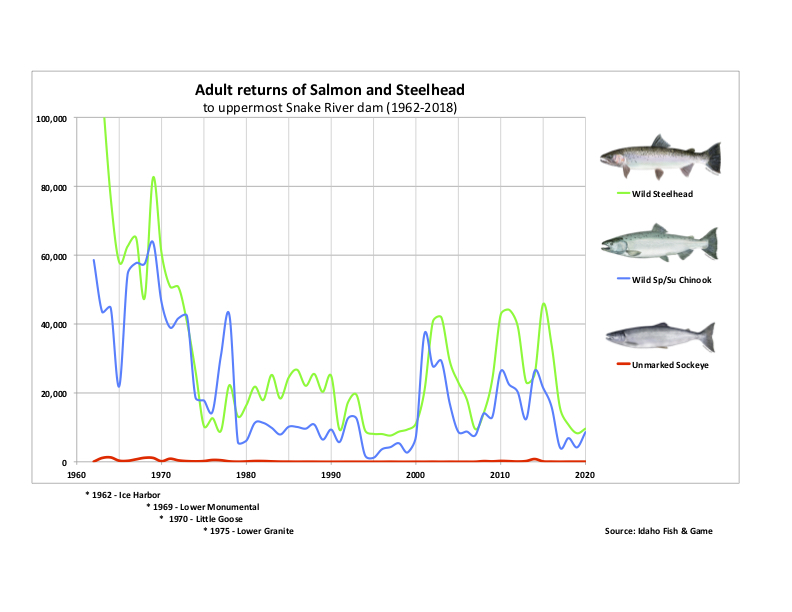forum
library
tutorial
contact

Electric Rate Hikes, Power Shortages Must Be
Part of Breaching Snake Dams Discussion
by Editorial Board
Tri-City Herald, May 16, 2022
|
the film forum library tutorial contact |

|
Electric Rate Hikes, Power Shortages Must Be
by Editorial Board
|
In 2021 the Snake River spring and summer Chinook salmon run
was 27% higher than in 2020 and 55% percent higher than in 2019.
With soaring inflation and rising fuel costs, the last thing Washington state citizens need is the thought of a huge price increase on their electric bill.
That's a point that needs to be hammered home as talks over breaching the Snake River dams heat up.
The Bonneville Power Administration has foreseen wholesale price hikes of 50% if the dams are removed and replaced with wind or solar batteries.
Finding out how that might translate to the average citizen's budget should be a key part of the discussion. Northwest RiverPartners has said ratepayers likely would pay an additional 25%.
With Gov. Jay Inslee's push for more clean energy, it is tough to fathom how his goals can be reached if we decimate our carbon-free, hydropower supply.
Last year, Inslee and Sen. Patty Murray launched a joint analysis of how to replace the benefits of the four lower Snake River dams, and it won't be long before their report is released.
Never mind that the topic has been researched to death -- primarily because those who want the dams removed can't accept it when results don't align with the narrative they want. So, tax dollars have been spent to study the issue again and again.
It was just a few years ago that the state allocated $750,000 for a task force to study the effects to Eastern Washington if the dams were breached.
 We said at the time that the effort was a waste of money because the state has no authority over whether the dams are removed -- only Congress has that.
We said at the time that the effort was a waste of money because the state has no authority over whether the dams are removed -- only Congress has that.
And in the end, that particular report didn't tell us anything we didn't already know. It mostly summarized views on both sides and left us hanging.
In addition, there's also the comprehensive federal Environmental Impact Statement, which took years to complete. It concluded in 2020 that the Snake dams should remain because, among other benefits, they are absolutely critical to providing affordable, reliable and carbon-free energy for the Northwest.
Along with that, repeated studies by the National Oceanic and Atmospheric Administration (NOAA) have found that breaching or removing the Snake River dams would boost salmon runs only slightly, if at all.
And let's not leave out Idaho Rep. Mike Simpson, who favors dam breaching. Simpson, though, acknowledged the benefits that the dams provide, as well as the enormous financial losses that would happen to the region if the dams went away.
His proposal estimated it would take $33 billion to manage the damage.
But now, here we are again awaiting the findings of another analysis.
This latest look at dam breaching, however, is of greater concern. Murray's involvement puts the discussion at the federal level where decisions about the dams would be made.
The Biden Administration is getting involved, and Republican Reps. Dan Newhouse and Cathy McMorris Rodgers are concerned about the White House Council on Environmental Quality, which is bringing together federal agencies to seriously consider breaching the dams.
We repeatedly have said that we care about salmon and the environment. But this laser-like focus on breaching the Snake dams takes away from other problems that harm fish, like pollution in Puget Sound.
We might add that in 2021 the Snake River spring and summer Chinook salmon run was 27% higher than in 2020 and 55% percent higher than in 2019.
But these are the kinds of statistics that get overlooked or dismissed. Emotion often overrides the data.
So dam supporters might want to use emotion as well. The hit to the wallet usually gets attention, as does concern over the loss of power.
Take a look at California. State officials there are warning of shortfalls in electricity this summer, according to The Sacramento Bee.
In order to help combat that, The Bee said that plans to shut down several high-polluting, gas-fired power plants on the Orange County coast are now postponed, and the state also is considering postponing the 2025 planned closure of its last nuclear plant located near San Luis Obispo.
What does that tell us?
We don't know what the Inslee-Murray report will conclude, but it wouldn't hurt if Tri-City officials and other stakeholders were prepared for any outcome.
learn more on topics covered in the film
see the video
read the script
learn the songs
discussion forum
